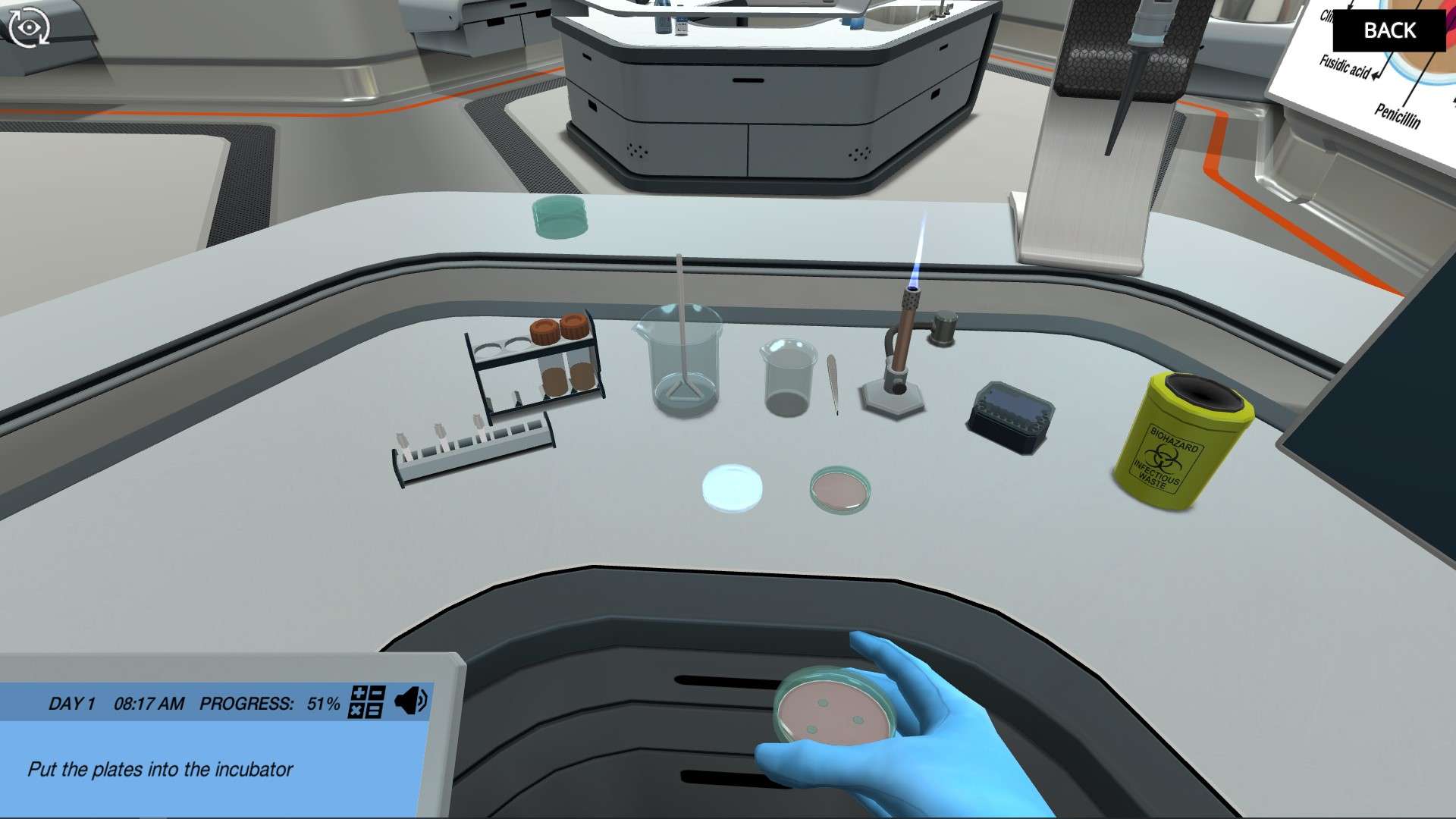Heading 1
Heading 2
Heading 3
Heading 4
Heading 5
Heading 6
Lorem ipsum dolor sit amet, consectetur adipiscing elit, sed do eiusmod tempor incididunt ut labore et dolore magna aliqua. Ut enim ad minim veniam, quis nostrud exercitation ullamco laboris nisi ut aliquip ex ea commodo consequat. Duis aute irure dolor in reprehenderit in voluptate velit esse cillum dolore eu fugiat nulla pariatur.
Block quote
Ordered list
- Item 1
- Item 2
- Item 3
Unordered list
- Item A
- Item B
- Item C
Bold text
Emphasis
Superscript
Subscript
About This Simulation
A dental patient’s recurrent infection is becoming dangerously septic. Your task is to investigate the cause using diffusion disc assays and prevent further cases by exploring sterilization, decontamination & selectively toxic infection control methods.
Learning Objectives
- Explain how and why microbial colonization occurs
- Recognize potential sources of contamination.
- Describe the consequences of unregulated population growth.
- Describe the ideal environments for microbial growth and how they can be manipulated.
- Appreciate different levels of selective toxicity
- Describe modes of microorganism growth control.
- Define selective toxicity and what it means for host organisms.
- Differentiate between disinfectants, antiseptics, and antimicrobials.
- Explain the utility of antimicrobial agents
- Appreciate why different antimicrobials are effective against different infections.
- Select an appropriate antimicrobial to target a given microorganism.
- Compare the effectiveness of different antimicrobial compounds.
About This Simulation
Lab Techniques
- Diffusion Disc Assays
- Sterilization techniques
- Decontamination methods
Related Standards
- No direct alignment
- No direct alignment
- B.1 Microbiology: organisms in industry
Learn More About This Simulation
What would you do if the first line treatment for an infection stopped working? How can you do your part to control infection spread in a clinical setting? In this simulation, you will work alongside a dentist to investigate a potentially deadly tooth infection and figure out how to control the spread of microbes using decontamination and sterilization processes.
Test antimicrobial compounds using diffusion disc assays
To discover the reason for the patient’s persistent infection, you will use a diffusion disc assay to investigate the sensitivity of a bacterial infection to a first line treatment. Closely related to the widely recognized Kirby Bauer assay, the diffusion disc assay will allow you to determine the effectiveness of antimicrobial compounds. By taking the lead in the technical set-up, data acquisition and interpretation parts of the assay you’ll develop a scientifically critical approach to experimentation. Using the virtual lab reduces assay processing time from two days to only a few minutes—a truly focused and engaging experience!
Holographically visualise bacterial growth and death
3D holograms exploring bacterial colony growth in the presence and absence of selectively toxic compounds support your diffusion disc assay investigations.The antimicrobial mechanisms of cell death and the development of resistance will be demonstrated in real-time to create 3D visualizations of these abstract processes.
Share your discoveries
After investigating the patient’s case and critiquing the available decontamination methods available in the lab, June the Dentist is curious about what you’ve done and discovered. What can be revealed about the patient’s infection? Can your patient be saved?
For Science Programs Providing a Learning Advantage
Boost STEM Pass Rates
Boost Learning with Fun
75% of students show high engagement and improved grades with Labster
Discover Simulations That Match Your Syllabus
Easily bolster your learning objectives with relevant, interactive content
Place Students in the Shoes of Real Scientists
Practice a lab procedure or visualize theory through narrative-driven scenarios


FAQs
Find answers to frequently asked questions.
Heading 1
Heading 2
Heading 3
Heading 4
Heading 5
Heading 6
Lorem ipsum dolor sit amet, consectetur adipiscing elit, sed do eiusmod tempor incididunt ut labore et dolore magna aliqua. Ut enim ad minim veniam, quis nostrud exercitation ullamco laboris nisi ut aliquip ex ea commodo consequat. Duis aute irure dolor in reprehenderit in voluptate velit esse cillum dolore eu fugiat nulla pariatur.
Block quote
Ordered list
- Item 1
- Item 2
- Item 3
Unordered list
- Item A
- Item B
- Item C
Bold text
Emphasis
Superscript
Subscript
A Labster virtual lab is an interactive, multimedia assignment that students access right from their computers. Many Labster virtual labs prepare students for success in college by introducing foundational knowledge using multimedia visualizations that make it easier to understand complex concepts. Other Labster virtual labs prepare learners for careers in STEM labs by giving them realistic practice on lab techniques and procedures.
Labster’s virtual lab simulations are created by scientists and designed to maximize engagement and interactivity. Unlike watching a video or reading a textbook, Labster virtual labs are interactive. To make progress, students must think critically and solve a real-world problem. We believe that learning by doing makes STEM stick.
Yes, Labster is compatible with all major LMS (Learning Management Systems) including Blackboard, Canvas, D2L, Moodle, and many others. Students can access Labster like any other assignment. If your institution does not choose an LMS integration, students will log into Labster’s Course Manager once they have an account created. Your institution will decide which is the best access method.
Labster is available for purchase by instructors, faculty, and administrators at education institutions. Purchasing our starter package, Labster Explorer, can be done using a credit card if you are located in the USA, Canada, or Mexico. If you are outside of North America or are choosing a higher plan, please speak with a Labster sales representative. Compare plans.
Labster supports a wide range of STEM courses at the high school, college, and university level across fields in biology, chemistry, physics, and health sciences. You can identify topics for your courses by searching our Content Catalog.















